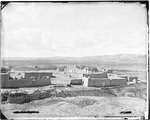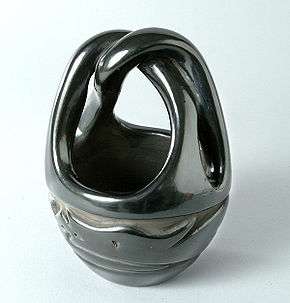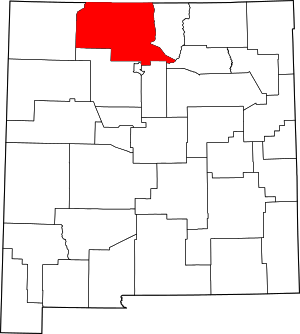Santa Clara Pueblo, New Mexico
Santa Clara Pueblo (in Tewa: Kha'po Owingeh [xɑ̀ʔp’òː ʔówîŋgè]) is a census-designated place (CDP) in Rio Arriba County, New Mexico, United States and a federally recognized tribe of Native American Pueblo people. Santa Clara Pueblo was established about 1550.
Santa Clara Pueblo, New Mexico | |
|---|---|
 House at Santa Clara Pueblo, 1910 | |
 Location of Santa Clara Pueblo | |
| Coordinates: 35°58′16″N 106°5′21″W | |
| Country | United States |
| State | New Mexico |
| County | Rio Arriba |
| Area | |
| • Total | 2.1 sq mi (5.4 km2) |
| • Land | 2.1 sq mi (5.4 km2) |
| • Water | 0.0 sq mi (0.0 km2) |
| Elevation | 5,607 ft (1,709 m) |
| Population (2010 census) | |
| • Total | 1,018 |
| • Density | 484.7/sq mi (188.5/km2) |
| Time zone | UTC-7 (Mountain (MST)) |
| • Summer (DST) | UTC-6 (MDT) |
| ZIP code | 87532 |
| Area code(s) | 505 |
| FIPS code | 35-70390 |
| GNIS feature ID | 0928813 |
Santa Clara Pueblo | |
 | |
| Nearest city | Española, New Mexico |
| Area | 24 acres (9.7 ha) |
| NRHP reference No. | 74001199[1] |
| NMSRCP No. | 231 |
| Significant dates | |
| Added to NRHP | November 5, 1974 |
| Designated NMSRCP | December 30, 1971 |
The pueblo is a member of the Eight Northern Pueblos, and the people are from the Tewa ethnic group of Native Americans who speak the Tewa language. The pueblo is on the Rio Grande, between Ohkay Owingeh (formerly San Juan Pueblo) to the north and San Ildefonso Pueblo to the south.
Santa Clara Pueblo is famous for producing hand-crafted pottery, specifically blackware and redware with deep engravings. The pueblo is listed on the National Register of Historic Places.
Geography
Santa Clara Pueblo is located at 35°58′16″N 106°5′21″W (35.971124, -106.089111),[2] about 1.5 miles south of Española on NM 30.
According to the United States Census Bureau, the CDP has a total area of 2.1 square miles (5.4 km2), all of it land.
Demographics
The 2010 census found that 1,018 people lived in the CDP,[3] while 1,182 people in the United States reported being exclusively Santa Claran[4] and 1,425 people reported being Santa Claran exclusively or in combination with another group.[5]
History

Tewa people lived in the Pueblo area for millennia before they met Spanish Conquistador Juan de Oñate and his exploration party on July 11, 1598.[6] Pueblo archaeology shows that Ancestral Puebloans lived in the general region as far back as 1200 BC.
First visited in 1541, a segment of Francisco Coronado's expeditionary force met with the residents of the nearby Caypa Pueblo. After annexation of the region into the Spanish Kingdom, and as part of the 1601 expansion of Oñate's colonial capital,[7] a chapel was built there by 1617. Fray Alonso de Benavides established a mission in 1628.[6] The mission was abandoned on the lead up to the Great Pueblo Revolt of 1680.
This Pueblo joined forces with others nearby and fought against the Spanish Royal Government in 1680 in the revolt. The original and unoccupied chapel was destroyed. Two other chapel buildings would be constructed there. The current church replaced the former in 1918.
In 1782, a small pox outbreak decimated the population. The eighth section of the Act of July 22, 1854 mandated a census of the newly acquired possessions of the US government. In review of the land's title, the pueblo presented a Spanish Royal decree dated October 15, 1713 that the title to land and various pueblos could be expected. Though lost, the decree on the title papers, if ever they existed, assured protection of the pueblos' right to protection of their homelands from encroachment. The result of the title research led this Pueblo community to be of the first recognized by United States Congress.
Arts
Among the arts practiced at Santa Clara Pueblo, pottery is one of the most well-known.[8] Traditionally, pottery was made primarily by girls and women, and while many potters today are women, there are many men who make pottery as well. Santa Clara Pueblo potters are known for their black polished and red polished pottery in a distinctive style, especially the use of incised work. "Knife-wing" or eagle feather designs are common on Santa Clara pottery[9][10][11] There are a number of well-known ceramic artists from Santa Clara. Four approaches are used in the decoration of the majority of Santa Clara Pueblo ceramics: painted designs, impressed patterns, incised designs, and resist-firing with incised or sgraffito designs.[8][8]
Notable tribal members and residents

- Angela Baca, matriarch of the Santa Clara melon potters
- Gregory Cajete, author and educator
- Tammy Garcia, ceramic artist and sculptor
- Luther Gutierrez, potter
- Margaret Gutierrez, potter
- Joseph Lonewolf, potter
- Nora Naranjo Morse, contemporary artist and filmmaker
- Linda and Merton Sisneros, potters
- Paul Speckled Rock, award-winning potter and bronze sculptor, gallery owner
- Anita Louise Suazo, traditional potter
- Roxanne Swentzell, contemporary ceramicist and bronze sculptor, Native plant activist, mother of ceramic, poetry, and performance artist Rose B. Simpson
- Rose B. Simpson, internationally recognized mixed-media, ceramic, and performance artist
- Margaret Tafoya, celebrated Santa Clara traditional potter
- Pablita Velarde, celebrated Santa Clara painter
- Nathan Youngblood, traditional potter
See also
- Puye Cliff Dwellings - the ruins of an abandoned pueblo and National Monument managed by Santa Clara Pueblo.
- Santa Clara Indian Reservation
- National Register of Historic Places listings in Rio Arriba County, New Mexico
References
- "National Register Information System". National Register of Historic Places. National Park Service. July 9, 2010.
- "US Gazetteer files: 2010, 2000, and 1990". United States Census Bureau. 2011-02-12. Retrieved 2011-04-23.
- U.S. Census Bureau (2010). "NM - Santa Clara CDP". United States Census 2010. Retrieved March 10, 2018.
- Census 2010 American Indian and Alaska Native Summary File (AIANSF) - Sample Data, Pueblo of Santa Clara alone (H58)
- Census 2010 American Indian and Alaska Native Summary File (AIANSF) - Sample Data, Pueblo of Santa Clara alone or in any combination (H58) & (100-299) or (300, A01-Z99) or (400-999)
- "New Mexico Office of the State Historian - people". newmexicohistory.org. Retrieved 22 April 2018.
- "Santa Clara Pueblo--American Southwest--A National Register of Historic Places Travel Itinerary". www.nps.gov. Retrieved 22 April 2018.
- LeFree, Betty (1975). Santa Clara pottery today. University of New Mexico Press. pp. 46–56. OCLC 948286978.
- Berger, Guy (2004). Pueblo and Navajo contemporary pottery and directory of artists. Schiffer, Nancy. (2nd ed., rev. and enl ed.). Atglen, PA: Schiffer. pp. 67–77. ISBN 0764318969. OCLC 57013886.
- National Park Service, Santa Clara Pueblo accessed 2010-05-26
- Indian Pueblo Cultural Center, Santa Clara Pueblo Archived 2008-09-18 at the Wayback Machine accessed 2010-05-26
External links
- Indian Pueblo Cultural Center - Santa Clara Pueblo
- Santa Clara Pueblo Community Library
- Santa Clara Pueblo at National Park Service
- Santa Clara Pueblo pottery gallery
- Children of the Clay: A Family of Pueblo Potters, the Swentzell family of Santa Clara Pueblo
